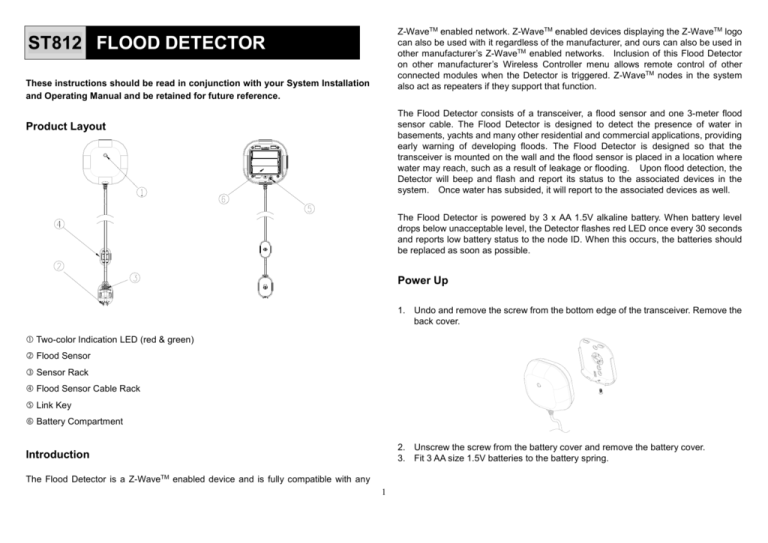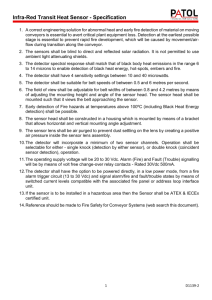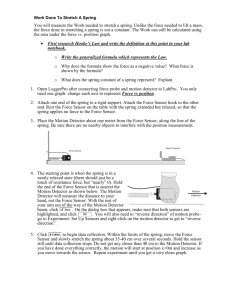ST812 - Everspring of America
advertisement

Z-WaveTM enabled network. Z-WaveTM enabled devices displaying the Z-WaveTM logo can also be used with it regardless of the manufacturer, and ours can also be used in other manufacturer’s Z-WaveTM enabled networks. Inclusion of this Flood Detector on other manufacturer’s Wireless Controller menu allows remote control of other connected modules when the Detector is triggered. Z-WaveTM nodes in the system also act as repeaters if they support that function. ST812 FLOOD DETECTOR These instructions should be read in conjunction with your System Installation and Operating Manual and be retained for future reference. The Flood Detector consists of a transceiver, a flood sensor and one 3-meter flood sensor cable. The Flood Detector is designed to detect the presence of water in basements, yachts and many other residential and commercial applications, providing early warning of developing floods. The Flood Detector is designed so that the transceiver is mounted on the wall and the flood sensor is placed in a location where water may reach, such as a result of leakage or flooding. Upon flood detection, the Detector will beep and flash and report its status to the associated devices in the system. Once water has subsided, it will report to the associated devices as well. Product Layout The Flood Detector is powered by 3 x AA 1.5V alkaline battery. When battery level drops below unacceptable level, the Detector flashes red LED once every 30 seconds and reports low battery status to the node ID. When this occurs, the batteries should be replaced as soon as possible. Power Up 1. Undo and remove the screw from the bottom edge of the transceiver. Remove the back cover. Two-color Indication LED (red & green) Flood Sensor Sensor Rack Flood Sensor Cable Rack Link Key Battery Compartment 2. Unscrew the screw from the battery cover and remove the battery cover. 3. Fit 3 AA size 1.5V batteries to the battery spring. Introduction The Flood Detector is a Z-WaveTM enabled device and is fully compatible with any 1 Function Description Exclusion 1. 2. Reset 4. Refit the battery cover by fastening its screw. Include to or Exclude from a Z-WaveTM 1. Press link key three times within 1.5 second. Beep once whenever link key is pressed once. 2. Within 1 second, press and hold the link key until beep tone stops. Long beep for 5 seconds Network 3. In the rear casing, there is a link key which is used to carry out inclusion, exclusion, reset or association. When first power is applied, its two-color LED flashes on and off alternately and repeatedly at 2-second intervals. It implies that it has not been assigned a node ID and cannot work with Z-Wave enabled devices. The Flood Detector will stay “awake” for 10 minutes when power is first applied to allow time for configuration. Please get familiar with the terms below before starting the operations. Function Association IDs are excluded and all of preset value will be reset to factory default. 1. Have Z-Wave Controller entered association mode. Or Pressing link key three times within 1.5 second to begin the association operation. 2-second on, 2-second off Beep once whenever link key is pressed once. 2. There are two groupings - 1 and 2. Refer to Z-Wave’s Groups as described on page 3 & 4. Including a node ID allocated by Z-Wave Controller means inclusion. Excluding a node ID allocated by Z-Wave Controller means exclusion. Failed or success in including/excluding the node ID can be viewed from the Z-Wave Controller. Description Inclusion Add a Z-Wave enabled device (e.g. Flood Detector) to Z-Wave network. Exclusion Delete a Z-Wave enabled device (e.g. Flood Detector) from the network. Association After inclusion, you have to define the relationship between devices. Through association, device can be assigned as master/slave, and specify which slave is going to be controlled by which master. Reset Have Z-Wave Controller entered exclusion mode. Pressing link key three times within 1.5 second will enter exclusion mode. Audible & Visual Indication Beep once whenever link key is pressed once. Restore Flood Detector to factory default. Installation The table below lists an operation summary of basic Z-Wave functions. Please refer to the instructions for your Z-WaveTM Certificated Primary Controller to access the setup function, and to include/exclude/associate devices. Function Description No node ID The Z-Wave Controller does not allocate a node ID to the Detector. Inclusion 1. Have Z-Wave Controller entered inclusion mode. 2. Pressing link key three times within 1.5 second will enter inclusion mode. A clean smooth surface is required to mount the Flood Detector securely. The length of flood sensor cable is 3 meters. If a 3-meter cable is too long, roll up the cable and fasten it by twist ties. The transceiver should be placed as high up as possible on the wall to improve communication and to prevent it from coming into contact with water in case of flooding. After completion of battery insertion and set up, follow the below procedures: Audible & Visual Indication 2-second on, 2-second off 1. Attach the flood sensor near the floor. 2. Use the back cover, flood sensor cable rack and sensor rack as a template to mark the position of fixing holes on the wall. Drill the holes and insert the plastic wall plugs supplied respectively. Beep once whenever link key is pressed once. 2 1-1 Grouping 1 (Max. node 1) 1-1-1 Power Applied command The Detector will send ALARM_REPORT command to the nodes of Grouping 1 to inform the devices that the Detector is powered up. ALARM_REPORT Command: [Command Class Alarm, Alarm Type = 0x02, Alarm Level = 0x01] 1-1-2 Flood Event Report (Binary Sensor Report) Once the Detector has been triggered by water, the Detector will send SENSOR_ALARM_REPORT to the nodes of Grouping 1 to inform them there is a flood event; meanwhile, its red LED will flash for one minute and beep for 30 seconds. Wait till water subsides, SENSOR_ALARM_REPORT will be sent to the associated devices. SENSOR ALARM REPORT Command: Event Present: [Command Class Sensor Alarm, Sensor Alarm Report, Sensor Type Water Leak Alarm State = 255 (0xFF), Seconds = 0x00] Event Clear: [Command Class Sensor Alarm, Sensor Alarm Report, Sensor Type Water Leak Alarm State = 0x00(0), Seconds = 0x00] 3. Fix the back cover, flood sensor cable rack and sensor rack using the fixing screws provided. 4. Refit the transceiver to the back cover and secure with the fixing screw supplied. 5. Place the flood sensor cable and flood sensor to its rack. 1-1-3 Low Battery Report (Alarm Command Class) When the battery level of the Detector drops to an unacceptable level, the Detector will send a low battery command to the node of Grouping 1; meanwhile, the Detector will flash red LED once every 30 seconds. Note: The transceiver should never be submerged in water. ALARM REPORT Command: [Command Class Alarm, Alarm Type = 0x01, Alarm Level = 0xFF] Programming 1-2 Grouping 2 (Max. nodes 3) 1. Z-Wave’s Groups (Association Command Class Version 2) The Flood Detector supports two association groups with one node support for Grouping 1 and three nodes support for Grouping 2. This has the effect that when the Detector is triggered, all devices associated with the Detector will receive the relevant reports. 1-2-1 There are two kinds of reports: ALARM_REPORT and SENSOR_ALARM_REPORT. 3 Control other Z-Wave devices When the Detector has been triggered, it will control other Z-Wave devices for operation by sending Basic Set command to the nodes of Grouping 2; meanwhile, the Detector will flash red LED for one minute and beep for 30 seconds. 3-2 Wakeup Command Class The unit stays in sleep status for the majority of time in order to conserve battery power. However, it can be woken up at specified intervals by setting WAKE_UP_INTERVAL_SET command by Z-Wave Controller. After the unit wakes up, it will send Wakeup Notification Command to the node ID that requires to be reported. The minimum and maximum wakeup interval is 60 seconds and 194 days respectively. Allowable interval among each wakeup interval is 1 second, such as 60, 61, 62 …. Basic Set Command: Event Present: [Command Class Basic, Basic Set, Value = Basic set level] Event Clear: [Command Class Basic, Basic Set, Value = 0x00(0)] 2. Z-Wave’s Configuration 2-1 Basic Set Level When Basic Set Command is sent where contains a value, the receiver will take it for consideration; for instance, if a lamp module is received the Basic Set command of which value is decisive as to how bright of dim level of lamp module shall be. 4. Command Classes The Flood Detector supports Command Classes including… *COMMAND_CLASS_SENSOR_BINARY *COMMAND_CLASS_BASIC *COMMAND_CLASS_CONFIGURATION *COMMAND_CLASS_WAKE_UP_V2 *COMMAND_CLASS_MANUFACTURER_SPECIFIC *COMMAND_CLASS_VERSION *COMMAND_CLASS_ASSOCIATION_V2 *COMMAND_CLASS_BATTERY *COMMAND_CLASS_SENSOR_ALARM Example: 0: OFF 1-99: ON (Binary Switch Device) Dim Level (Multilevel Switch Device) Function Parameter Number Basic Set level 1 Size 1 Range 0~99 Default Operation 99 Configuration Command 1. When water is detected, the Detector flashes red LED for one minute and emits beep sound intermittently for 30 seconds. In the meantime, an event report will be sent to the node ID as well. In normal mode, the detection interval is set for one minute. If the Detector is triggered, it will not be triggered again until one minute has passed and water has subsided, thus avoiding false trigger. 3. Advanced Programming 3-1 Low Battery Indication The users can also enquire the battery status of the Detector by sending BATTERY_GET command via Z-Wave Controller. Once the Detector receives the command, it will return BATTERY_REPORT command. The Detector will send Battery_Level = 255 (0xFF) command to the Z-Wave Controller to inform that the Detector is in low battery status. 2. When water has subsided, the Detector will send a signal to notify the associated devices. 3. When the battery power drops to a certain level, the red LED will flash once every 30 seconds and an event report will be sent to the node ID. BATTERY REPORT Command: [Command Class Battery, Battery Report, Battery Level = 20%-100%] 4 - Troubleshooting Symptom LED not indicating and not working No beep sound and LED not indicating when triggered Possible Cause Recommendation Batteries have not been fitted or insufficient battery power Check out if batteries are fitted or replace new batteries Break down Do not open up the Detector and send it for repair Not carry out inclusion Include a node ID allocated by Z-Wave Controller - Increase the separation between the equipment and receiver. Connect the equipment into an outlet on a circuit different from that to which the receiver is connected. Consult the dealer or an experienced radio/TV technician for help. This device complies with Part 15 of the FCC Rules. Operation is subject to the following two conditions: (1) This device may not cause harmful interference, and (2) this device must accept any interference received, including interference that may cause undesired operation. FCC Caution: Any changes or modifications not expressly approved by the party responsible for compliance could void the user's authority to operate this equipment. This transmitter must not be co-located or operating in conjunction with any other antenna or transmitter. Specification* WARNING: Do not dispose of electrical appliances as unsorted municipal waste, use separate collection facilities. Battery Type 1.5V AA x 3 pieces Battery Life 2 years** Operating Frequency 868.42MHz (ST812-1) / 908.42MHz (ST812-2) *Specifications are subject to change without notice **10 triggers per day A501111533R02 Contact your local government for information regarding the collection systems available. 2013/07 If electrical appliances are disposed of in landfills or dumps, hazardous substances can leak into the groundwater and get into the food chain, damaging your health and well-being. When replacing old appliances with new ones, the retailer is legally obligated to take back your old appliance for disposal at least for free of charge. Federal Communication Commission Interference Statement This equipment has been tested and found to comply with the limits for a Class B digital device, pursuant to Part 15 of the FCC Rules. These limits are designed to provide reasonable protection against harmful interference in a residential installation. This equipment generates, uses and can radiate radio frequency energy and, if not installed and used in accordance with the instructions, may cause harmful interference to radio communications. However, there is no guarantee that interference will not occur in a particular installation. If this equipment does cause harmful interference to radio or television reception, which can be determined by turning the equipment off and on, the user is encouraged to try to correct the interference by one of the following measures: Reorient or relocate the receiving antenna. 5








